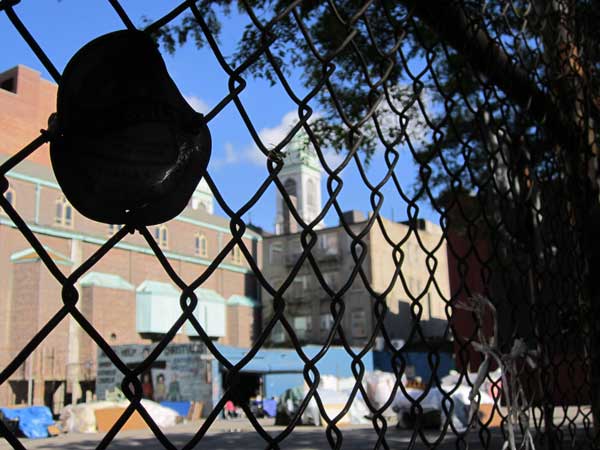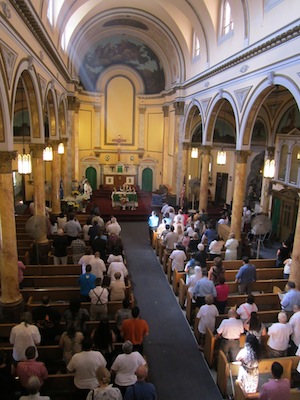

BY LINCOLN ANDERSON | Finding spiritual solace and finding vintage treasures will no longer be occurring — at least not in an organized manner — on Avenue A between 12th and 11th Sts.
The final Mass at Mary Help of Christians Church was held this past Sunday, and the flea market on the church’s parking lot had also closed for good.
The Catholic Archdiocese is selling off the prime East Village property at Avenue A, which also includes the Don Bosco Salesians rectory adjacent to the church and the church’s former school on E. 11th St., which closed in 2006.
Mary Help of Christians’ worshipers will be moving to nearby Immaculate Conception Church, at 14th St. and First Ave., where the flea market will also relocate and start up again the first week in October.
Mary Help of Christians was built about 100 years ago. The archdiocese closed it as a regular church five years ago, saying the number of worshipers didn’t justify keeping it open. However, the church did continue to hold Sunday Mass — at first, one Mass in English and one in Spanish — and more recently, only one in Spanish. The Masses typically drew about 80 to 100 people.
Joseph Zwilling, the archdiocese’s spokesperson, did not confirm if a deal had been made yet for the Avenue A property, only saying, “It’s been on the market to be sold.”
He said he “wouldn’t be surprised” if some of the Mary Help of Christians congregants also wind up at St. Brigid’s Church, which is slated to reopen soon after a lengthy renovation.
“We do not have a specific date yet, but we do hope for it to open sometime this fall,” Zwilling said of the historic “Irish famine church,” at Eighth St. and Avenue B.
In addition, the congregants of St. Emeric’s Church, at the far east end of E. 13th St., whose parish is being merged with St. Brigid’s, will also be worshiping at the renovated Avenue B church.
Several years ago, St. Ann’s Church on E. 12th St. was closed and redeveloped as an N.Y.U. dorm, with only the church’s front wall left standing.
Basically, one could say the East Village’s “wandering Catholics” have been moving from church to church as one or another house of worship closes.
“It just shows how ‘overchurched’ we were down there — St. Emeric’s, St. Ann’s, St. Brigid’s…,” said Zwilling.
Referring to the East Village’s so-called “national parishes” that catered to specific ethnic groups, the spokesperson said, “One was founded as an Italian parish, one was founded as a German parish, one was an Italian parish,” all of which left the neighborhood with an overabundance of churches, in the archdiocese’s view.
After Mary Help of Christians was closed in 2007, Antonia Fisher was given the keys and put in charge of opening and closing the church for Sunday Mass. Last Sunday, she opened the place’s front doors for the last time around 10:15 a.m. She attended the E. 12th St. church for more than 40 years.
“All my kids came here,” she said, “and they got married here. They did everything — communion, confirmation… . I’m here since 13 years old. My three grandchildren came up through third grade, till the school closed. I went to school here.”
A retired nurse, Fisher lives nearby at E. 12th St. and Avenue C.
“Believe me, it is tough,” she said of having to leave the building. “Something that you know inch by inch, and square part by square part, it’s very hard to leave it.”
After the final Mass, as congregants shared a meal of slices of 6-foot-long Subway sandwiches, rice and beans and roast chicken, Fisher walked the aisles with teary eyes, greeting friends.
Judy Aponte, another longtime member of the church, also helped ready it for the final service.
“I feel heartbroken,” she said. “I feel like I lost some family. It’ll be very hard to walk by here and not see this building anymore — we know the Church is not a building, but this is where we did everything. It’s going to be hard, because the Hispanic community is breaking up.”
The main Mass at Immaculate Conception is in English, and the church is creating a chapel in its basement for the Mary Help of Christians worshipers to hold their Spanish Mass.
“A lot of people are unhappy that they’re not giving us a Mass proper in the new church,” she said.
Father Joseph O’Meara, who used to give the Mass in the former St. Ann’s in the 1950s, gave the final Mass for about 200 people at Mary Help of Christians, speaking mostly in English. In between his words, a small church choir sang in Spanish and played music — with guitar, two tambourines, a triangle and the steady percussive beat of wood sticks.
Speaking beforehand, Marlena Palacios, a teacher, said she doesn’t know yet which East Village church she’ll call her new spiritual home, and will check each one out.
“I will go where my heart is,” she said. She’s still upset about what happened to St. Ann’s.
“Unfortunately, St. Ann’s is not there,” she said. “I refuse to pass by that block because I think what they did is a joke — to just leave that little piece there — and I’m an N.Y.U. grad. I thought it was just me, but a lot of people don’t like it — you don’t have to be Catholic.”
She said she wished New York could be more like Europe and preserve its history.
“This is destroying [the neighborhood] — the East Village lost its churches,” she said. “This is not the East Village of 20 years ago. It’s so crowded now, you have to cross the street. People smoking on the sidewalk day and night. It’s extremely overcrowded — and they want to have more. Mothers with their strollers have to swerve around people.”
Among the worshipers at the last Mass was Sister Domenica, who was the Mary Help of Christians School principal for six years, and a first-grade teacher there for 18 years before that.
“Oh, it’s heartbreaking,” she said. Recalling her teaching days, she said, “We had 75 students in a class. It was tough — but we had the parents behind us. If they were naughty, their parents got after them.”
Anthony Contrino, who attended the school from third to eighth grade, said, “You should have seen it here in the 1950s when they had bingo here — it was in the church basement, in the auditorium and on three levels across the street in the convent on Saturday nights.” Through bingo, the church was finally able to pay off its mortgage debt in the 1960s.
Evangelina Romero, a lawyer, wrote the canon appeal to try to save the church.
“I was hoping to get married here, but it’s not going to happen now,” she said.
As usual, Manuel Albino performed his duties as Mary Help of Christians senior altar server. At 38, he’s kept at it long after most altar boys have “aged out.”
“Most people don’t think about what a spiritual experience it is, because it’s usually associated with boys,” he said.
Asked if he knew details of the church’s rumored sale, he said, “It’s a mystery,” adding, “and I have connections at 1011,” referring to the archdiocese’s headquarters at 1011 First Ave.
Also at the final Mass was Suresh Dianand, who grew up in the East Village and attended both the church and school with Albino until he moved to Brooklyn as a young teen.
“I grew up here before it was the East Village,” Dianand noted with a chuckle. But he left the Catholic Church and instead today attends Judson Church on Washington Square South.
“I’m gay,” he said, “and I’m not going to go to a church that doesn’t accept me for who I am.” As for why he came back this time, he said, “For a special occasion, I would step foot into a Catholic church — but as regular parishioner, no.”
Meanwhile, people who arrived at the flea market Sunday found an empty blacktop lot behind a locked chain-link fence.
Marie McGovern, who lives in the women’s shelter at Avenue B and 10th St., said she regularly shopped at the flea market.
“Oh yeah, I like their clothing,” she said. “I’d buy utensils.”
Lauren Zlasko, who was on her way to a nearby community garden, said it was a real vintage market.
“It was affordable — it wasn’t like Brooklyn Flea,” she said.
A man with an Eastern European accent who came by looking for computer parts said, “At the store, they charge $40 for the charger. Here you could get for $5.”
M.J. Fernando, from Sri Lanka, who works in a Midtown video store, was hoping to buy “some fishing machine — two or three.” He made as if to turn a fishing reel to help explain.
“I send to my country,” he said. “My friend told me before, have here.”

















